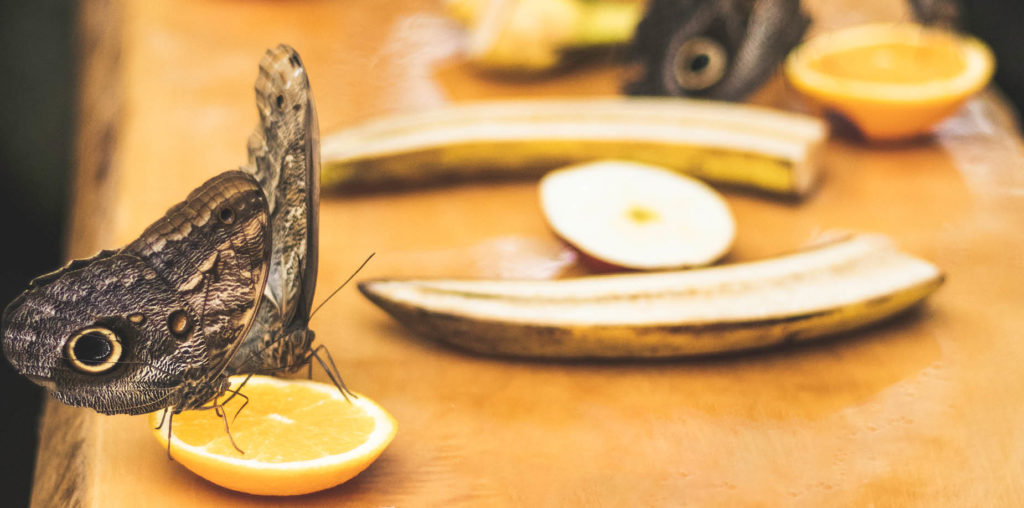by Deborah Rogers –
Imagine being transported to a tropical paradise. The air would be damp but warm, the light bright and the colours around you vivid green with splashes of hot pink, yellow and red. For one brief moment this month I didn’t have to imagine that warmth and colour as I went behind the scenes at Brentwood Bay’s Butterfly Gardens.
Arriving before the usual opening hours allowed me to see some of the sights that the public doesn’t usually witness. The climate-controlled environment is programmed to simulate a real tropical environment so although it was warm and humid inside, the lighting and temperature were still 10° lower than normal – in its night mode – and just increasing, meaning the wildlife was fresh and busy, starting their day and waiting for breakfast!
I was grateful to spend some time in the company of Kurtis Herperger the Gardens Manager, who commented on my visit’s great timing as just the day before they had received a delivery of butterfly pupae from the Philippines. 1,450 puppa had arrived and needed processing, ready to hatch into the space. I’d meet Justin and Fallon who were prepping the pupae later.
What does it take to be an expert at the butterfly Gardens? Well, there’s not a specialist training course for that – the staff are really botanists and horticulturalists with knowledge gained through shared channels with other zoos and insectariums around the world. Really there’s just a few handfuls of experts across Canada. It’s not a subject you’d think about often but there are butterfly farms in Costa Rica and the Philippines that have devoted themselves to sustainable butterfly production. During the pandemic there have been problems with shipping but Butterfly Gardens have continued to support those farmers who are a vital part of the life cycle.
It’s been operating for nearly 30 years now and always changing and adapting. Case in point is the Insectarium, added a few years ago. There are all sorts of rare creatures that, incidentally, would be illegal if owned privately. The huge leaf cutter ant display had been piled up with fresh leaves just before I arrived and Kurtis advised that I’d want to look again after my tour and see what they’d done with them. I saw giant weevils, jungle nymphs, huge atlas beetles, and tiny, shiny rainbow stag beetles. I learned all sorts of facts as I walked the steamy room with Kurtis – you’ll have to pay a visit yourself if you want to know how long these beasties take to hatch, or what leaf cutter ants actually eat.
I’d expected the wildlife but hadn’t anticipated how incredible the tropical plants are when you get to wander right up to and under them. There are some varieties that you might even have in your home, only here they’re supersized. It lifted my heart to see the long fluffy pink chenille flower and enormous hibiscus blooms. There’s even papaya fruit growing high up in the canopy.
The sound is intense too. There’s the constant rushing of water that feeds the pools and water features, and there are birds squawking and screeching the whole time. It was a sensory overload after the still, grey day that I left outside.
In this saturated environment butterflies are constantly being released as they are born all day, every day. There are around 70 species of butterflies flying free, including the world’s largest moth. The giant atlas moth has a wing span of nearly a foot across. I didn’t get to see one but I did see those just arrived pupae being glued (yes, with a tiny dab of hot glue) to a strip so they could be hung up to develop: they’ll all emerge within five to seven days. Some species can hold their own population naturally because the environment works for them, but others need these additions. I was able to open the lid of a box of brand new, just hatched butterfly babies. They’ve never flown before and I watched the first test of their wings.
There are other creatures: tree frogs, geckos, tortoises, macaws, “Little E,” an incredibly friendly parrot, a flamingo, an Australian whistling tree duck and the now internet-famous Spike, an iguana with an eye-patch (after an operation for his glaucoma). The animals are all rehomed or rescued.
I spent just an hour behind the scenes at Butterfly Gardens but I felt I’d travelled miles! The butterflies are spectacular, but perhaps overshadowed by all the other characters whose home is in the water or trees there. I did stop again to look at those leaf cutter ants on the way out. They had already demolished their leaf pile, transporting the pieces on their backs to their nest. They are a blur of activity, a reminder of the natural world’s constant motion.
Photos by Amanda Cribdon Photography.




